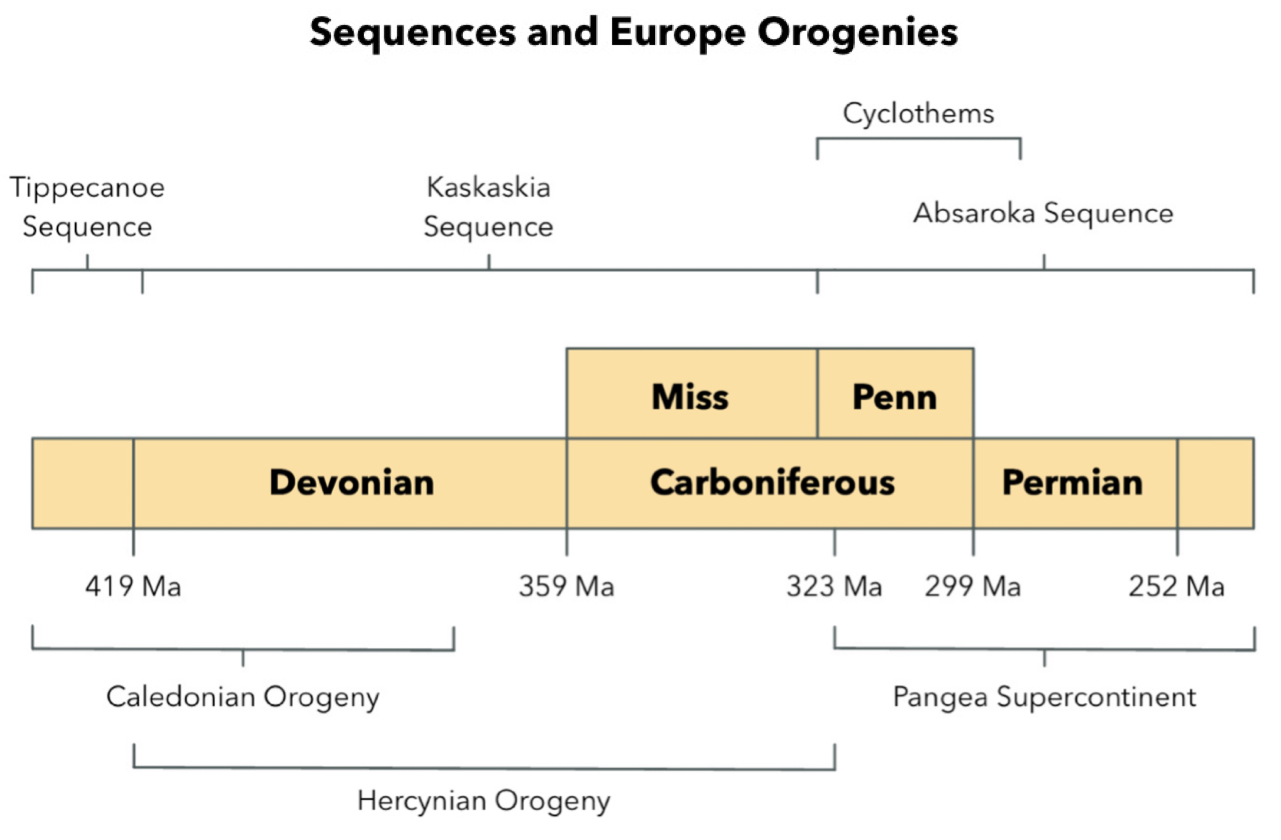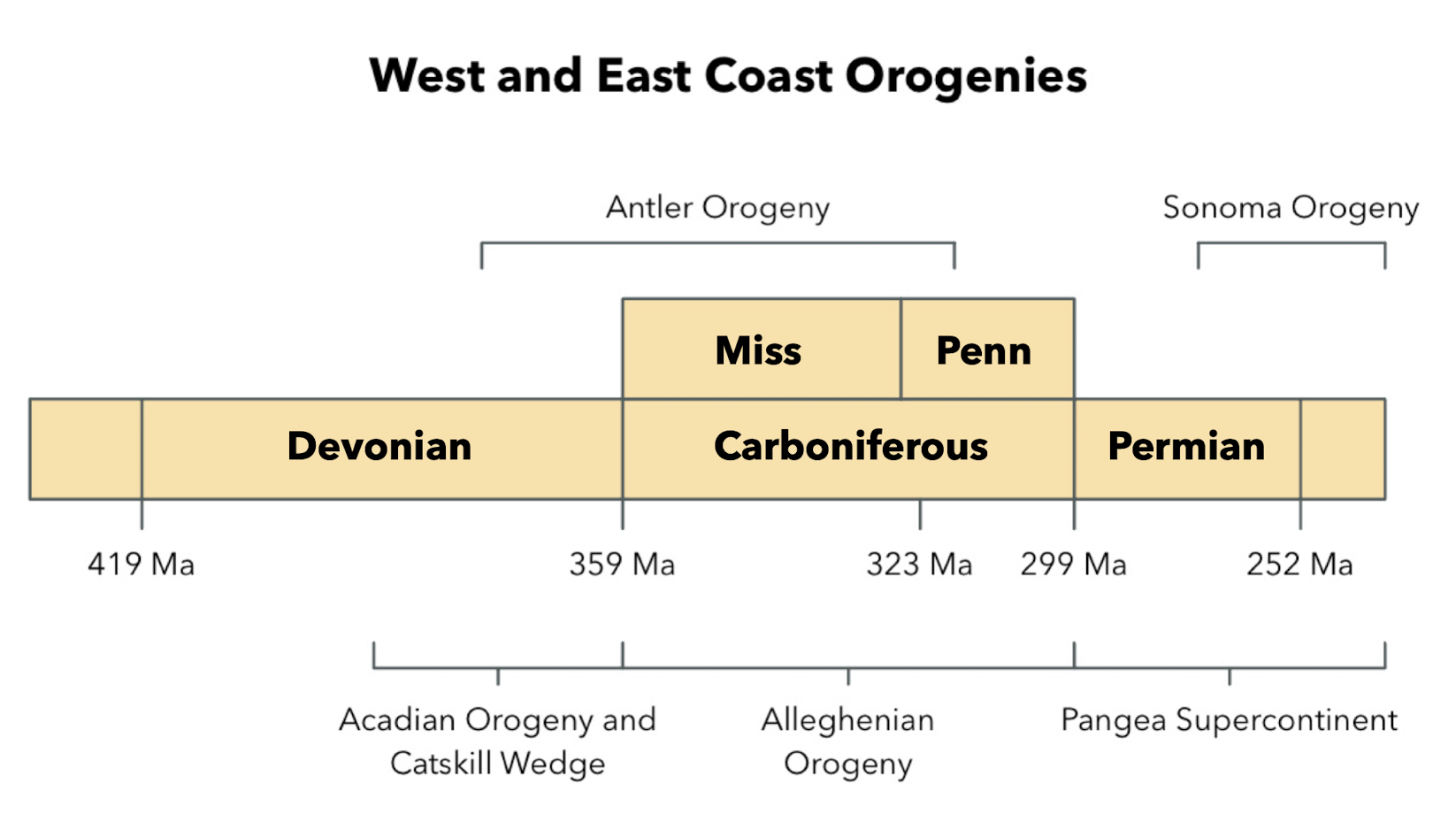Lecture 12: Late Paleozoic Geology
The Paleozoic Era
The Carboniferous
Carboniferous used throughout the world
Coal beds in north-Central England
Subdivided by English/European geologists: lower and upper
U.S. found a comparable system
Mississippian and Pennsylvanian
Distinguish coal-bearing layers of the Pennsylvanian from the mostly limestone Mississippian.
The Carboniferous Period was dominated by coal.
Late Paleozoic Geologic Events
Similar to early Paleozoic, sedimentary strata were formed in “packages” due to rising and falling seas.
With falling seas comes unconformities
Kaskaskia and Absaroka sequences
For mountain building, a clash of continents was occurring on the east coast, with some smaller events happening elsewhere
Pangea forming
Acadian (east), Alleghenian (east), Antler (west), and Hercynian (Europe).
The Devonian World
Fourth Period of the Paleozoic
Sequences and Europe Orogenies

West and East Coast Orogenies

Kaskaskia Sequence
The End of the Silurian
Marks end of Tippecanoe sequence and beginning of the Kaskaskia sequence.
A major continent wide unconformity is found at the end of Early Devonian.
Late Silurian
Regression of the Tippecanoe sequence (sea level fall)
Kaskaskia
Throughout the Devonian and into the Mississippian, sea level rises.
Sandstone at the bottom, then shale, then limestone.
Oriskany Sandstone
Oriskany Sandstone: Initial deposit of the Kaskaskia sequence as sea level begins to rise.
Consists of very mature and clean quartz sands that eroded from Taconic mountains in the east.
Marcellus/Chattanooga Shale
During Kaskaskia sequence, mountains uplift in east during Acadian Orogeny.
Eroded material carried west by streams to form a massive sedimentary deposit called Catskill clastic wedge.
Inside wedge, we find a widespread deposit of black muds that eventually formed the Chattanooga Shale.
Widespread, easy to recognize → important marker for correlation.
Darkness of deposit suggest water was anoxic (lacked free oxygen).
Possible source for natural gas (hydrofracking).
Carbonates
Sea level continues to rise.
Mountains that provide mud to the Chattanooga Shale have reduced (less clast sediments); eroded material away.
Oceans became more oxygenated and carbonates became the dominant deposit (with lots of fossils).
End of the Kaskaskia Sequence
Marine regression at the end of Mississippian drained continent.
Results in major continental unconformity between the Late Mississippian and Early Pennsylvanian.
Similar to Sauk-Tippecanoe and Tippecanoe-Kaskaskia.
New sequence begins → Absaroka
What About Western N. America?
Western part of craton was too far from eastern mountains to receive many clastic sediments.
As a result, Middle and Upper (Late) Devonian strata are largely limestone (extensive reefs).
We can find these Devonian and Mississippian Limestone in the Frenchman Mountains, Red Rock, and Mount Charleston.
Possible Alamo Impact
Late Devonian, possible bolide (meteorite) impacted southwest NV.
Due to mountain building processes through time, we can’t see impact crater.
A thick bed of carbonate breccia found throughout state.
Absaroka Sequence
Craton-Wide Unconformity
End of Mississippian, exposed terrain eroded away to form widespread regional unconformities in the world.
The resulting unconformity separates strata into Mississippian and Pennsylvanian.
The Absaroka cratonic sequence includes strata ranging from Pennsylvanian through Triassic/Early Jurassic.
Pennsylvanian strata near eastern highland are thicker consisting of sandstones, shales, and coal beds.
Moving west, this thins out and is dominated by half marine and half non-marine rocks.
Cyclicity
Cyclicity: a pattern where events or conditions repeat in a regular; a cycle.
During the Pennsylvanian we are generally seeing an overall rise in sea level (Absaroka)
Steady sequence
However, strata show a marked cyclicity (or pulses) of changing sea level also occurring.
Smaller and shorter time period.
Repetitive pattern seen on other continents.
Cyclothems
Cyclothems: A cyclic repetition of sequences of marine and non-marine strata.
Sea level rise produces marine strata.
Sea level fall produces non-marine strata (clasts).
Common in Pennsylvanian, not Mississippian.
Valuable because they contain coal beds and can be correlated over great distances.
Results from repetitive step-wise advances and retreats of epicontinental seas.
Late Paleozoic Repetition
About over 100 cyclothems in N. America
Occur on a much finer scale than the major sea level sequences.
Potential causes:
Worldwide rise (melt) and fall (cooling) of sea levels due to glaciers.
Spasmodic tectonic up and down motions of the continent.
Fluctuations of cyclic climatic change influencing sediment supply to deltas.
Coal Swamps
Sandstones of the cyclothems represent river/delta deposits.
Coal bearing shales represent vast coal swamps (jungle-like vegetation).
Immense areas must have been densely vegetated.
Coal forms by the accumulation and compaction of vegetation into peat.
Peat: lowest grade of coal we can access.
As vegetative matter accumulated it became peat.
Accumulating economically viable coal requires an immense volume of original vegetation.
Further compaction, increases in economic grade.
Coal Formation
Increasing time, pressure, and heat results in high grade
Peat is low grade
Brown coal is intermediate grade
Black coal is high grade
Bituminous coal burns hotter and cleaner than lower-grade coals.
Coal is a dying source.
Permian Sediments
Permian conditions east of Antler uplift were quieter than those to the west.
Region occupied by a shallow sea.
Formed Kaibab Limestone (Grand Canyon, Frenchman Mt., Blue Diamond Hill).
While Kaibab Limestone deposited, a relatively deep marine basin developed in what is now WY, MT, and ID
Chert, sandstone, mudstone, and limestone, in addition to dark layers of phosphorous rich rocks.
Phosphoria Formation
Important resource of phosphorus today.
Towards late Permian, sea level is a bit lower
Western orogeny’s shaping Cordillera.
Eastern orogeny’s shaping Appalachians
Most Permian rocks are deposited in the Great Permian Basin.
Restricted basin that alternates between organic rich mudstone deposits and halite deposits that aid in trapping oil.
This is a major oil producing region
Acadian Orogeny
Acadian Orogenic Event
Paleozoic, continents coming together to form supercontinent Pangea (last supercontinent).
Mid- to Late Devonian, a microcontinent named Avalon (Avalonia) terrane collided with the northern margin of the N. American craton.
Middle-Late Devonian Geology
The Acadian mountain belt extended from Newfoundland to West Virginia
Thick, folded sequences of basin sediments (that were metamorphosed).
Granitic intrusions (dimension stone)
Dimension Stone
Dimension stone: Granitic intrusions; a resource for decorative rock.
Sediments Galore
Catskill Wedge consisting of sandstones to shales over short distances.
Deeply buried shale, known as Marcellus Shale (Chattanooga Shale is an extension of the Marcellus), is one of the largest known reservoirs of natural gas.
Chattanooga/Marcellus Shale
Most Natural Gas Reservoirs on the Eastern US are from the Marcellus / Chattanooga Shale.
Alleghenian Orogeny
Alleghenian Orogeny
Also known as the Appalachian Orogeny
Collision of Gondwana w/ N. America beginning in the Mississippian and into the Permian.
Connecting North America and northwestern Africa.
Long orogenic belt extending laterally 1600 km from southern New York to central Alabama producing extensive thrust faulting, uplift, and metamorphism.
Formation of Supercontinent Pangea
Baltica (Europe) joined together with North America during Caledonian orogeny (late Ord-Sil-Mid Dev).
Formation of Northern Appalachian Mountains; Acadian Orogeny (middle Dev)
Formation of Southern Appalachian Mountains: Alleghenian Orogeny (Permian) - Connecting North America and northwestern Africa.
Europe
Caledonian Orogeny
Recognized primarily in western Europe.
Slightly predates the Acadian Orogeny in North America.
Continental warpings, sediment distribution and organisms are similar across North America and Europe during this time.
Catskill Orogenic wedge is similar in age to the European Old Red Sandstone wedge.
The Caledonian and Acadian Orogenies were likely opposite sides of the same coin.
Hercynian Orogeny
Central Europe was the site of great mountain building.
Caused by collision of Northern Africa with Europe.
Silurian-Devonian-Carboniferous
Interconnected supercontinent → Pangea
Cordillera Continued
Out West
The Cordillera refers to the western system of mountain ranges in North America.
From Rocky Mountains to the Pacific Coast and from Mexico to Alaska.
Rockies, Sierra Nevada’s, Coast Ranges
During the most Early Paleozoic, this region was nearly flat, laying near/below sea level.
Early Split in the Neoproterozoic
Eastern Antarctica or Australia rifted off Laurentia at Late Neoproterozoic.
Passive Margin developed in Western US/Canada (Laurentia) until Devonian.
Orogeny Begins
With subduction
Passive margin until Ordovician/Silurian
A Panthalassic Plate (Proto-Pacific) is moving against Laurentia
Subduction zone with volcanic chain
Antler Orogeny
Late Devonian through Mississippian-Pennsylvanian
First orogeny in the west coast.
Island arc accretion western margin of North America
The convergence was accompanied by massive thrust-faulting.
Roberts Mountains in central NV
Foreland Basin
Foreland basins form when lithosphere flexes downward in front of mountain belt in response to added load of thickened crust that results from collision of two plates.
Basin → like a bowl
Sediments eroded from mountain belt accumulate in foreland basin, causing it to further subside and make room for additional sediments.
Add weight means more depression
The Antler Mountains produced large source of coarse clastics that was over 5000 meters deep.
Such a thickness indicates basins were subsiding as they were being filled.
Sonoma Orogeny
Another orogeny occurring on west coast.
Occurred at the end of the Permian into the Triassic.
Another collision of an eastward-moving island arc.
Review Questions
What/when were the major sequences? What is the evidence?
Kaskaskia Sequence (385 to 320 million years ago): Characterized by widespread marine transgressions and regressions, evidenced by carbonate deposits and marine fossils like brachiopods and corals.
Absaroka Sequence (320 to 260 million years ago): Marked by frequent sea-level fluctuations with alternating marine and non-marine sediments, evidenced by coal beds, sandstones, shales, and fossils of both marine and terrestrial organisms.
What/when were the major orogenies? What is the evidence?
Caledonian Orogeny (around 490 to 400 million years ago): Formed the Caledonian Mountains in Scotland and Scandinavia due to the collision of Laurentia and Avalonia, evidenced by folded and metamorphosed rocks.
Acadian Orogeny (375 to 325 million years ago): Created the northern Appalachian Mountains from the collision of Avalonia with North America, evidenced by folded rock layers and extensive Devonian sediments.
Hercynian (Variscan) Orogeny (350 to 290 million years ago): Resulted from the collision between Laurussia and Gondwana, forming the Appalachian and Variscan Mountains, evidenced by folded and metamorphosed rock layers.
Alleghanian Orogeny (325 to 250 million years ago): Produced the Appalachian Mountains and other ranges through the collision of North America and Africa during Pangaea's formation, evidenced by extensive folding and faulting.
Antler Orogeny (around 380 to 250 million years ago): Affected the western margin of North America, creating the Antler Mountains and evidenced by sedimentary rock layers with associated folds and faults.
What sedimentary rocks formed during this time?
Sandstone, shale, limestone, coal, and conglomerates
How is coal formed? What are cyclothems? Why did they occur?
How is coal formed?: Coal forms from the accumulation and compression of plant material in swampy, oxygen-poor environments over millions of years.
What are cyclothems?: Cyclothems are repeating sequences of sedimentary rock layers, typically including coal, sandstone, shale, and limestone, that reflect cyclic changes in sea level and sedimentation.
Why did they occur?: Cyclothems occurred due to fluctuating sea levels and climate conditions that alternated between marine transgressions and regressions, causing periodic changes in sediment deposition.
What was happening in western Laurentia at this time?
Early stages of what would become the Cordilleran Mountain Range began forming due to tectonic forces and volcanic activity.
Varied sea levels led to the deposition of different sedimentary rocks, including sandstones, shales, and limestones.
Large sedimentary basins, like the Great Basin, developed as a result of tectonic activity and sediment deposition.